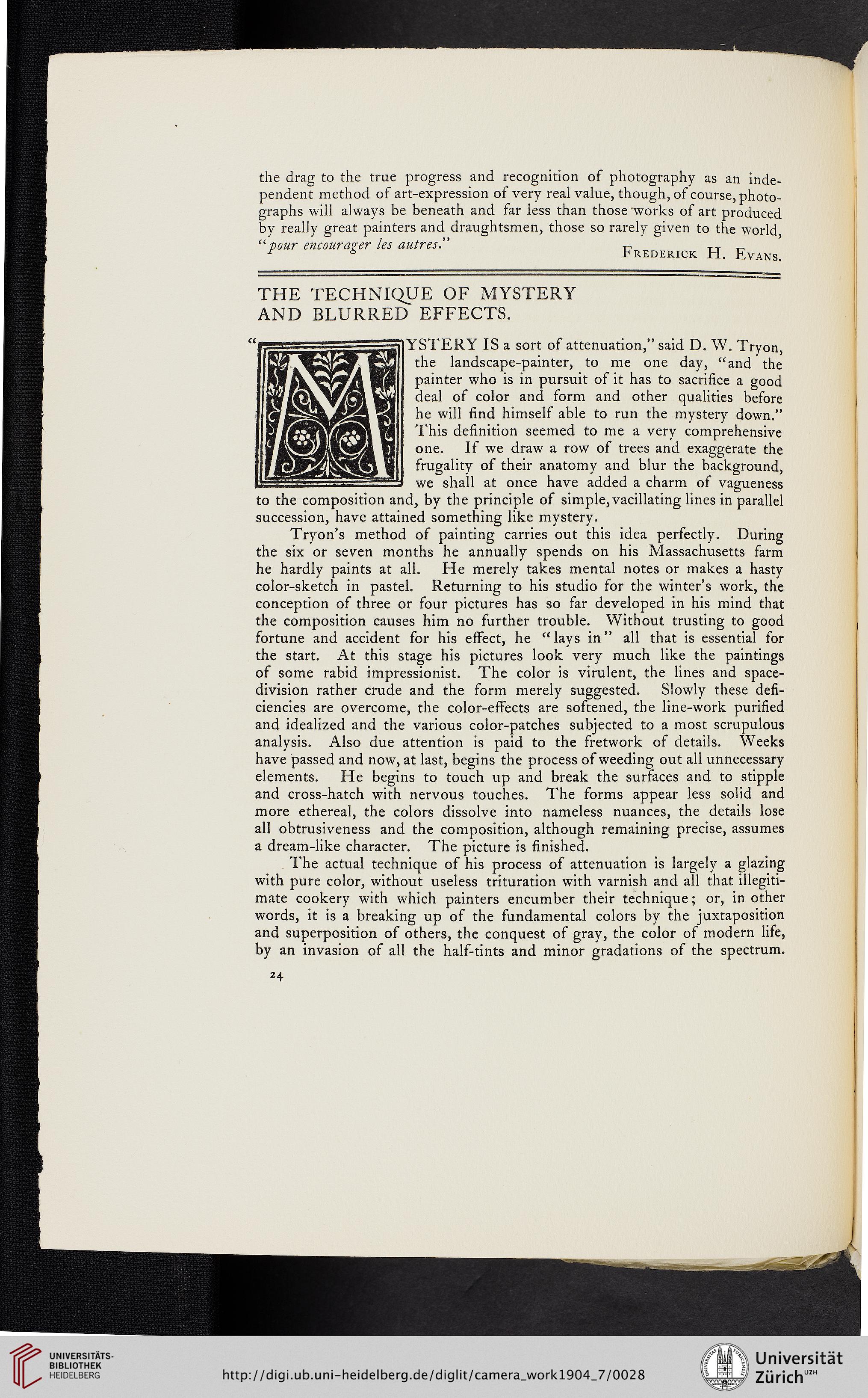Für diese Seite ist auch eine manuell angefertigte Transkription bzw. Edition verfügbar. Bitte wechseln Sie dafür zum Reiter "Transkription" oder "Edition".
the drag to the true progress and recognition of photography as an inde-
pendent method of art-expression of very real value, though, of course, photo-
graphs will always be beneath and far less than those works of art produced
by really great painters and draughtsmen, those so rarely given to the world ,
“pour encourager les autres .” Frederick H . Evans .
THE TECHNIQUE OF MYSTERY
AND BLURRED EFFECTS.
MYSTERY IS a sort of attenuation,” said D. W. Tryon,
the landscape-painter, to me one day, "and the
painter who is in pursuit of it has to sacrifice a good
deal of color and form and other qualities before
he will find himself able to run the mystery down.”
This definition seemed to me a very comprehensive
one. If we draw a row of trees and exaggerate the
frugality of their anatomy and blur the background,
we shall at once have added a charm of vagueness
to the composition and, by the principle of simple,vacillating lines in parallel
succession, have attained something like mystery.
Tryon's method of painting carries out this idea perfectly. During
the six or seven months he annually spends on his Massachusetts farm
he hardly paints at all. He merely takes mental notes or makes a hasty
color-sketch in pastel. Returning to his studio for the winter'swork, the
conception of three or four pictures has so far developed in his mind that
the composition causes him no further trouble. Without trusting to good
fortune and accident for his effect, he " lays in” all that is essential for
the start. At this stage his pictures look very much like the paintings
of some rabid impressionist. The color is virulent, the lines and space-
division rather crude and the form merely suggested. Slowly these defi-
ciencies are overcome, the color-effects are softened, the line-work purified
and idealized and the various color-patches subjected to a most scrupulous
analysis. Also due attention is paid to the fretwork of details. Weeks
have passed and now, at last, begins the process of weeding out all unnecessary
elements. He begins to touch up and break the surfaces and to stipple
and cross-hatch with nervous touches. The forms appear less solid and
more ethereal, the colors dissolve into nameless nuances, the details lose
all obtrusiveness and the composition, although remaining precise, assumes
a dream-like character. The picture is finished.
The actual technique of his process of attenuation is largely a glazing
with pure color, without useless trituration with varnish and all that illegiti-
mate cookery with which painters encumber their technique; or, in other
words, it is a breaking up of the fundamental colors by the juxtaposition
and superposition of others, the conquest of gray, the color of modern life,
by an invasion of all the half-tints and minor gradations of the spectrum.
24
pendent method of art-expression of very real value, though, of course, photo-
graphs will always be beneath and far less than those works of art produced
by really great painters and draughtsmen, those so rarely given to the world ,
“pour encourager les autres .” Frederick H . Evans .
THE TECHNIQUE OF MYSTERY
AND BLURRED EFFECTS.
MYSTERY IS a sort of attenuation,” said D. W. Tryon,
the landscape-painter, to me one day, "and the
painter who is in pursuit of it has to sacrifice a good
deal of color and form and other qualities before
he will find himself able to run the mystery down.”
This definition seemed to me a very comprehensive
one. If we draw a row of trees and exaggerate the
frugality of their anatomy and blur the background,
we shall at once have added a charm of vagueness
to the composition and, by the principle of simple,vacillating lines in parallel
succession, have attained something like mystery.
Tryon's method of painting carries out this idea perfectly. During
the six or seven months he annually spends on his Massachusetts farm
he hardly paints at all. He merely takes mental notes or makes a hasty
color-sketch in pastel. Returning to his studio for the winter'swork, the
conception of three or four pictures has so far developed in his mind that
the composition causes him no further trouble. Without trusting to good
fortune and accident for his effect, he " lays in” all that is essential for
the start. At this stage his pictures look very much like the paintings
of some rabid impressionist. The color is virulent, the lines and space-
division rather crude and the form merely suggested. Slowly these defi-
ciencies are overcome, the color-effects are softened, the line-work purified
and idealized and the various color-patches subjected to a most scrupulous
analysis. Also due attention is paid to the fretwork of details. Weeks
have passed and now, at last, begins the process of weeding out all unnecessary
elements. He begins to touch up and break the surfaces and to stipple
and cross-hatch with nervous touches. The forms appear less solid and
more ethereal, the colors dissolve into nameless nuances, the details lose
all obtrusiveness and the composition, although remaining precise, assumes
a dream-like character. The picture is finished.
The actual technique of his process of attenuation is largely a glazing
with pure color, without useless trituration with varnish and all that illegiti-
mate cookery with which painters encumber their technique; or, in other
words, it is a breaking up of the fundamental colors by the juxtaposition
and superposition of others, the conquest of gray, the color of modern life,
by an invasion of all the half-tints and minor gradations of the spectrum.
24


